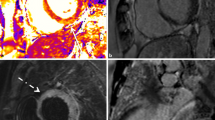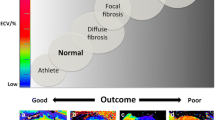Abstract
CMR provides pathology-like insights of myocardial abnormality, such as hyperemia, edema, necrosis and fibrosis, which is in-vivo, non-invasive and real-time. Hence, it is most likely to become one alternative tool for mimicking pathology, so-called pathologicalized imaging due to its extraordinary tissue characteristics. This article aims to call for a wider clinical application of CMR with more attention on its tissue characterization value.
Similar content being viewed by others
References
Bax JJ, Di Carli M, Narula J, Delgado V (2019) Multimodality imaging in ischaemic heart failure. Lancet 393(10175):1056–1070
Gulati A, Jabbour A, Ismail TF et al (2013) Association of fibrosis with mortality and sudden cardiac death in patients with nonischemic dilated cardiomyopathy. JAMA 309(9):896–908
Zhou D, Xu J, Zhao S et al (2020) CMR publications from China of the last more than 30 years. Int J Cardiovasc Imaging. https://doi.org/10.1007/s10554-020-01873-x
Kim RJ, Fieno DS, Parrish TB et al (1999) Relationship of MRI delayed contrast enhancement to irreversible injury, infarct age, and contractile function. Circulation 100(19):1992–2002
Chan RH, Maron BJ, Olivotto I et al (2014) Prognostic value of quantitative contrast-enhanced cardiovascular magnetic resonance for the evaluation of sudden death risk in patients with hypertrophic cardiomyopathy. Circulation 130(6):484–495
Moravsky G, Ofek E, Rakowski H et al (2013) Myocardial fibrosis in hypertrophic cardiomyopathy: accurate reflection of histopathological findings by CMR. JACC Cardiovasc Imaging 6(5):587–596
Nakamori S, Dohi K, Ishida M et al (2018) Native T1 mapping and extracellular volume mapping for the assessment of diffuse myocardial fibrosis in dilated cardiomyopathy. JACC Cardiovasc Imaging 11(1):48–59
Xu J, Zhuang B, Sirajuddin A et al (2020) MRI T1 mapping in hypertrophic cardiomyopathy: evaluation in patients without late gadolinium enhancement and hemodynamic obstruction. Radiology 294(2):275–286
Carrick D, Haig C, Ahmed N et al (2016) Myocardial hemorrhage after acute reperfused ST-segment-elevation myocardial infarction: relation to microvascular obstruction and prognostic significance. Circ Cardiovasc Imaging 9(1):e004148
Garcia J, Barker AJ, Markl M (2019) The role of imaging of flow patterns by 4D flow MRI in aortic stenosis. JACC Cardiovasc Imaging 12(2):252–266
Leng S, Ge H, He J et al (2020) Long-term prognostic value of cardiac MRI left atrial strain in ST-segment elevation myocardial infarction. Radiology. https://doi.org/10.1148/radiol.2020200176
Ferreira VM, Schulz-Menger J, Holmvang G et al (2018) Cardiovascular magnetic resonance in nonischemic myocardial inflammation: expert recommendations. J Am Coll Cardiol 72(24):3158–3176
Funding
The study was supported by grant No. 81930044 and No. 81620108015 from the key projects of National Natural Science Foundation of China.
Author information
Authors and Affiliations
Contributions
All authors contributed to the study conception and design. Material preparation, data collection and analysis were performed by SZ. The first draft of the manuscript was written by SZ and all authors commented on previous versions of the manuscript. All authors read and approved the final manuscript.
Corresponding author
Ethics declarations
Conflict of interest
No potential conflicts of interest with respect to the research, authorship, and/or publication of this articles.
Additional information
Publisher's Note
Springer Nature remains neutral with regard to jurisdictional claims in published maps and institutional affiliations.
Rights and permissions
About this article
Cite this article
Zhao, S. Letter to the editor: is it time for imaging to level with pathology?. Int J Cardiovasc Imaging 36, 2249–2250 (2020). https://doi.org/10.1007/s10554-020-01936-z
Received:
Accepted:
Published:
Issue Date:
DOI: https://doi.org/10.1007/s10554-020-01936-z




